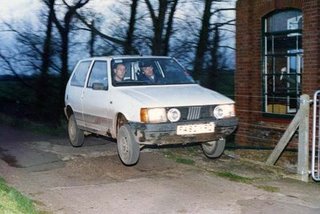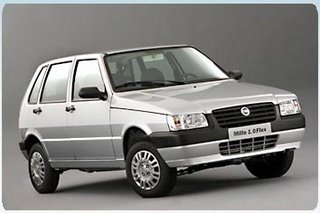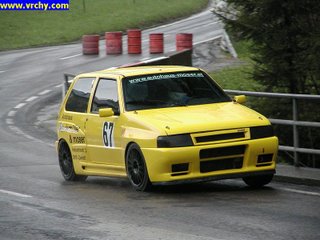




The Fiat Uno is a supermini produced by the Italian manufacturer Fiat. The Uno began production in 1983, and remains in production throughout the world today, though it ceased production in its native Italy in 1995.The Uno was launched in 1983 to replace the aging Fiat 127. Designed by Giorgetto Giugiaro's ItalDesign company, its tall, square body and a low drag coefficient of 0.34 won it much praise for interior space and fuel economy. It was voted Car of the Year in 1984 by a narrow margin over the Peugeot 205 (its key competitor) and the Mark 2 Volkswagen Golf. Initially, the Uno was offered with the 0.9 ohv, 1.1 and 1.3 138-series sohc petrol engines, as well as a 1.3 diesel engine. The Uno was available as either a 3 or 5 door hatchback.
From 1985, the new 1.0 SOHC Fully Integrated Robotised Engine (FIRE) powerplant was offered, which gave improved performance and economy. Also in 1985 the hot hatch version Uno Turbo variant was launched, with an IHI turbocharged Strada derived 1.3 146-series engine initially offering 105 bhp.
In September 1989 the Uno was given a mild facelift, which saw revisions to the bodywork that improved the drag coefficient to 0.30. The interior was also revised. At this time, the old 1.1 engine was replaced by a new FIRE version, and a new Tipo derived 1.4 engine replaced the Strada derived 1.3 in both naturally aspirated and Turbo versions, Uno Turbo i.e. variant was reestyled too, and upgraded with an Garret T2 turbine, Bosch LH Jetronic fuel ingection and better CX aerodinamic factor. Uno production ceased in its native Italy in 1995, with sales throughout Western Europe ceasing accordingly. Over 6 million Unos were sold in Europe. The Uno's replacement was the Fiat Punto, which had been launched in early 1994.
The Uno was the first Fiat to achieve real sales success in Britain, with 190,000 examples being sold in the first six years of production — amounting to an average of just over 27,000 a year.[citation needed] Its main selling points were a competitive asking price, low running costs, contemporary design and extremely spacious interior — as well as the advantage of a five-door model, something that the likes of the Ford Fiesta and Volkswagen Polo did not offer at the time.
But the Uno failed to shake off Fiat's image of making cars which failed to last as long as their counterparts. This was highlighted by the findings of a survey by Auto Express magazine,[citation needed] conducted in 2006, which revealed that it was the tenth most scrapped car in Britain - with just 5,179 of the pre-1990 range remaining.
After Western European production and sales ceased, the Uno continued to be manufactured and sold in many other regions. In South Africa, the Uno was assembled under licence by Nissan, which marketed it as the Uno up until 2005. Production in Fiat's factory in Poland ran until 2002. The car is still sold in Brazil, where a sedan version called the Duna or Prêmio and a station wagon called the Duna Weekend or Innocenti Elba were also available. Currently, the car is sold as the Fiat Mille, an entry-level model, and received its most recent facelift for the 2004 model year. The 2005 Brazilian range has received a Flex Fuel system, enabling the car to use ethanol or gasoline as fuel, both pure or in any proportion mixture; plus, there is a version fitted for unpaved roads called Mille Way, which includes a more ressistant suspension, larger wheels and side protections.The Uno is also assembled in CKD form in Pakistan, and recently upgraded Brazil built RHD Uno's will be exported to South Africa.
From 1985, the new 1.0 SOHC Fully Integrated Robotised Engine (FIRE) powerplant was offered, which gave improved performance and economy. Also in 1985 the hot hatch version Uno Turbo variant was launched, with an IHI turbocharged Strada derived 1.3 146-series engine initially offering 105 bhp.
In September 1989 the Uno was given a mild facelift, which saw revisions to the bodywork that improved the drag coefficient to 0.30. The interior was also revised. At this time, the old 1.1 engine was replaced by a new FIRE version, and a new Tipo derived 1.4 engine replaced the Strada derived 1.3 in both naturally aspirated and Turbo versions, Uno Turbo i.e. variant was reestyled too, and upgraded with an Garret T2 turbine, Bosch LH Jetronic fuel ingection and better CX aerodinamic factor. Uno production ceased in its native Italy in 1995, with sales throughout Western Europe ceasing accordingly. Over 6 million Unos were sold in Europe. The Uno's replacement was the Fiat Punto, which had been launched in early 1994.
The Uno was the first Fiat to achieve real sales success in Britain, with 190,000 examples being sold in the first six years of production — amounting to an average of just over 27,000 a year.[citation needed] Its main selling points were a competitive asking price, low running costs, contemporary design and extremely spacious interior — as well as the advantage of a five-door model, something that the likes of the Ford Fiesta and Volkswagen Polo did not offer at the time.
But the Uno failed to shake off Fiat's image of making cars which failed to last as long as their counterparts. This was highlighted by the findings of a survey by Auto Express magazine,[citation needed] conducted in 2006, which revealed that it was the tenth most scrapped car in Britain - with just 5,179 of the pre-1990 range remaining.
After Western European production and sales ceased, the Uno continued to be manufactured and sold in many other regions. In South Africa, the Uno was assembled under licence by Nissan, which marketed it as the Uno up until 2005. Production in Fiat's factory in Poland ran until 2002. The car is still sold in Brazil, where a sedan version called the Duna or Prêmio and a station wagon called the Duna Weekend or Innocenti Elba were also available. Currently, the car is sold as the Fiat Mille, an entry-level model, and received its most recent facelift for the 2004 model year. The 2005 Brazilian range has received a Flex Fuel system, enabling the car to use ethanol or gasoline as fuel, both pure or in any proportion mixture; plus, there is a version fitted for unpaved roads called Mille Way, which includes a more ressistant suspension, larger wheels and side protections.The Uno is also assembled in CKD form in Pakistan, and recently upgraded Brazil built RHD Uno's will be exported to South Africa.





No comments:
Post a Comment